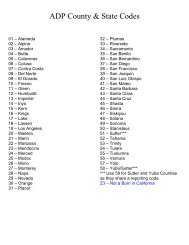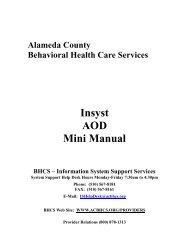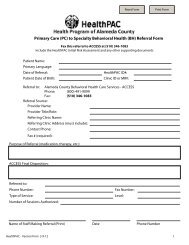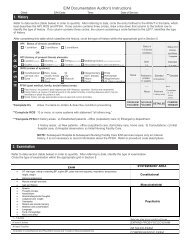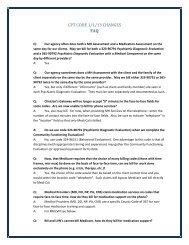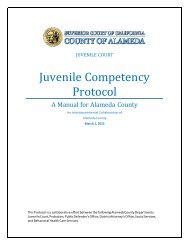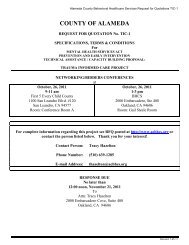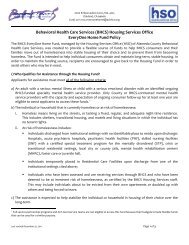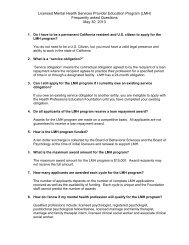CPT Code Changes for 2013 Frequently Asked ... - National Council
CPT Code Changes for 2013 Frequently Asked ... - National Council
CPT Code Changes for 2013 Frequently Asked ... - National Council
You also want an ePaper? Increase the reach of your titles
YUMPU automatically turns print PDFs into web optimized ePapers that Google loves.
1. Why are <strong>CPT</strong> codes changing?<strong>CPT</strong> <strong>Code</strong> <strong>Changes</strong> <strong>for</strong> <strong>2013</strong><strong>Frequently</strong> <strong>Asked</strong> QuestionsLast Updated 12/2/2012<strong>CPT</strong> code changes occur every year. The Current Procedural Terminology, or <strong>CPT</strong>, code set ismaintained by the American Medical Association and used to describe procedures and servicesby physicians and other health care professionals. <strong>CPT</strong> codes are used as the basis <strong>for</strong> billingthird-party payers, and changes to these codes can affect insurers’ coverage and pricingdecisions. The <strong>CPT</strong> code set is updated every year to reflect changes in technology andprocedures, but this year’s changes will result in a higher-than-usual impact on behavioral health.The last time major changes were made to the Psychiatry section was in 1998.2. What are some of the major changes between 2012 and <strong>2013</strong> <strong>for</strong> behavioral health?Several commonly used <strong>CPT</strong> codes from the Psychiatry section have been deleted or modified.<strong>Changes</strong> include:• Removal of evaluation and management (E/M) plus psychotherapy codes from thepsychiatry section (90805, 90807)• Deletion of pharmacologic management (providers to use appropriate E/M code, except<strong>for</strong> providers who cannot use E/M codes)• Psychotherapy and E/M services are distinguished from each other (time spent on E/Mservices is not counted towards psychotherapeutic services, and separate codes can beused in combination with one another)• Inclusion of add on codes <strong>for</strong> psychiatry, which are services per<strong>for</strong>med in addition to aprimary service or procedure (and never as a stand-alone service)• Addition of code 90785 <strong>for</strong> interactive complexity• New code <strong>for</strong> psychotherapy <strong>for</strong> a patient in crisis3. When will these changes take effect? Will there be any delay?Under HIPAA, the new <strong>CPT</strong> code set will take effect on January 1, <strong>2013</strong>. You should be in touchwith your payers about their transition timeline.4. Are these changes related to the ICD-10 changes?No. ICD-10 codes are used to describe diagnoses. <strong>CPT</strong> codes are used to describe procedures.<strong>Changes</strong> to each code set are independent of each other.* * *Last Updated 12/2/2012. For additional questions, contact NinaM@thenationalcouncil.org.<strong>CPT</strong>® five-digit codes, descriptions, and other data only are copyright 2012 by the American Medical Association(AMA). All Rights Reserved. No fee schedules, basic units, relative values or related listings are included in the<strong>CPT</strong>®. <strong>CPT</strong>® is a registered trademark of the American Medical Association (AMA).
5. Where can we find rates <strong>for</strong> each of these codes?Rates <strong>for</strong> individual services will be payer-specific. <strong>CPT</strong> codes describe individual services, andinsurance and other payers independently set rates <strong>for</strong> those services.Contracts with private payers usually have an appendix with a fee schedule. Some contracts aredesigned so the payer can change rates without amending a contract. If your contract is notdesigned in this way, it may require a contract amendment.Payers may not have assigned rates yet, so it may be some time be<strong>for</strong>e learning what the rateswill be <strong>for</strong> <strong>2013</strong>.On November 1, 2012, CMS published through regulation the relative value units (RVUs) <strong>for</strong>services <strong>for</strong> <strong>2013</strong> (except <strong>for</strong> crisis psychotherapy codes). This is the first step <strong>for</strong> establishingrates under Medicare. The psychiatry section of the published rule begins on page 531 of thisdocument: http://www.ofr.gov/OFRUpload/OFRData/2012-26900_PI.pdf.Organizations should be in touch with all payers about their implementation timelines, includingtheir state Medicaid agency, Medicare Administrative Contractors (MACs), and other third-partypayers.6. What are “add-on codes”?Add-on codes identify procedures that are carried out in addition to a primary procedure. Theyonly apply to services or procedures per<strong>for</strong>med by the same health care professional. Add-oncodes should only be reported along with a primary procedure, and must never be reported aloneas a stand-alone code.Examples of add-on codes are:• Add-on codes <strong>for</strong> psychotherapy: 90833 (30 min.), 90836 (45 min.), 90838 (60 min.)• Add-on code <strong>for</strong> interactive complexity: 90785An example <strong>for</strong> use of an add-on code:Evaluation and Management service plus 30 minute psychotherapy session by a psychiatrist:<strong>Code</strong> as: 99211 (or other appropriate level of E/M code) and 90833 (30 min psychotherapyadd-on)* * *Last Updated 12/2/2012. For additional questions, contact NinaM@thenationalcouncil.org.<strong>CPT</strong>® five-digit codes, descriptions, and other data only are copyright 2012 by the American Medical Association(AMA). All Rights Reserved. No fee schedules, basic units, relative values or related listings are included in the<strong>CPT</strong>®. <strong>CPT</strong>® is a registered trademark of the American Medical Association (AMA).
7. How do we submit add-on codes on claims? Do we include the + be<strong>for</strong>e the 5 digits?The add-on code is a second line on the claim, and must be submitted along with the primaryservice that it is supplementing. Do not include a “+” sign; only use the 5-digit code.8. What are Evaluation and Management (E/M) codes?Evaluation and Management (or E/M) is a category of medical services. This is not a newcategory of codes <strong>for</strong> <strong>CPT</strong>, though many medical providers in behavioral health used codes fromthe psychiatry section of the <strong>CPT</strong> book instead of the E/M section. Since the E/M-related codesin the Psychiatry section have been deleted, behavioral health medical services will have to becoded using E/M codes. The Centers <strong>for</strong> Medicare and Medicaid Services developed a fact sheeton E/M codes: http://www.cms.gov/Outreach-and-Education/Medicare-Learning-Network-MLN/MLNProducts/Downloads/Evaluation_Management_Fact_Sheet_ICN905363.pdf.Using E/M codes has an impact on documentation and service requirements, and providersshould be careful to learn about these be<strong>for</strong>e billing <strong>for</strong> them.The <strong>National</strong> <strong>Council</strong> will be holding a webinar on E/M code selection and documentation onDecember 3, 2012. Registration is available here. Slides and a recording of the presentation willbe posted here (after December 3).9. By using Evaluation and Management (E/M) codes, will psychiatrists have to takeblood pressure and other physical health care measurements?It depends on the level of code being billed. One commonly used set of guidelines on how tocode and document different E/M levels is the Centers <strong>for</strong> Medicare and Medicaid Services’“1997 Documentation Guidelines <strong>for</strong> Evaluation and Management Services.”Regardless the psychiatrist does not have to take the measurements her/himself.10. What is “Interactive Complexity”?Interactive complexity is a new term in <strong>CPT</strong> <strong>for</strong> <strong>2013</strong>. It refers to specific factors that complicatethe delivery of a psychiatric procedure. The code book lists specific circumstances where thismight apply, like needing to involve third parties like probation officers, interpreters, other legalguardians, etc.* * *Last Updated 12/2/2012. For additional questions, contact NinaM@thenationalcouncil.org.<strong>CPT</strong>® five-digit codes, descriptions, and other data only are copyright 2012 by the American Medical Association(AMA). All Rights Reserved. No fee schedules, basic units, relative values or related listings are included in the<strong>CPT</strong>®. <strong>CPT</strong>® is a registered trademark of the American Medical Association (AMA).
15. Will they reimburse <strong>for</strong> an intake code if client was already seen and billed <strong>for</strong>intake within the past 3 years?Yes, the 90791 and 90792 can be used subject to the payer’s approval <strong>for</strong> an establishedpatient. Limits to the use and reimbursement of these two codes must be determined with payer.For E/M, this would describe an established patient and the appropriate code would need to bereported.16. Can psychiatrists bill “add-on” codes with their E/M codes if they are not theprimary clinician providing the client’s psychotherapy?Psychiatrists can report add on codes such as psychotherapy with a primary E/M code. The workand documentation would need to support the reporting of the add-on code.17. Where can I find additional resources?The <strong>National</strong> <strong>Council</strong> is maintaining a website with resources <strong>for</strong> implementing these changes at:www.thenationalcouncil.org/cs/cpt_codes.We strongly recommend that each organization purchase a copy of the AMA’s <strong>CPT</strong> code book<strong>for</strong> <strong>2013</strong>. The code book contains complete definitions of each code, along with instructions onhow they can be used in combination with each other. Books can be purchased from the AMA at:www.amabookstore.com or (800) 621-8335.18. How do we get a copy of the November 9 th presentation, “<strong>CPT</strong> <strong>Code</strong> <strong>Changes</strong> <strong>for</strong><strong>2013</strong>: Impact on Behavioral Health”?The presentation slides and audio are available on the <strong>National</strong> <strong>Council</strong> website.www.thenationalcouncil.org/cs/cpt_codes.19. Who can we contact <strong>for</strong> more in depth consultation on use of E/M codes or thetransition to <strong>2013</strong> <strong>CPT</strong> codes?The <strong>National</strong> <strong>Council</strong> recommends contacting David Swann with MTM Services:David R. Swann, MA, LCAS, CCS, LPC, NCCSenior Healthcare Integration Consultant, MTM ServicesEmail: david.swann@mtmservices.orgPhone: (336) 710-3585* * *Last Updated 12/2/2012. For additional questions, contact NinaM@thenationalcouncil.org.<strong>CPT</strong>® five-digit codes, descriptions, and other data only are copyright 2012 by the American Medical Association(AMA). All Rights Reserved. No fee schedules, basic units, relative values or related listings are included in the<strong>CPT</strong>®. <strong>CPT</strong>® is a registered trademark of the American Medical Association (AMA).
20. Can non-psychiatrists (psychologists, LPCs, LCSWs) bill <strong>for</strong> 90791 even though itsdescription is “psychiatric diagnostic evaluation,” or will they no longer be able tobill <strong>for</strong> evaluations?Use of code 90791 is not limited to physicians. The <strong>CPT</strong> code book says that 90791 includes “anintegrated biopsychosocial assessment, including history, mental status, and recommendations.”There is a separate piece that describes the medical services to make it 90792.21. Do the new time requirements <strong>for</strong> psychotherapy (e.g., 90832, psychotherapy, 30minutes) include time <strong>for</strong> documentation by the provider? Under 90832, is 30minutes the minimum amount of time that must be met in order to consider this abillable session?The time reported is actual face-to-face time with the patient and/or family member (the patientneeds to be part of all or some of the service), so it does not include documentation time ifdocumentation is completed without the input of the patient and/or family member.If time dedicated to documentation is a concern, concurrent/collaborative documentation hasbeen shown to support compliance and efficiency, and therapists and clients alike find it to behelpful.When a selecting a time-based code <strong>for</strong> psychotherapy, the <strong>CPT</strong> instructions are that a “unit oftime is attained when the mid-point is passed.” Additionally, when codes are in sequential times,choose the code with the closest time. There<strong>for</strong>e:• 16-37 minutes <strong>for</strong> 90832 and 90833• 38-52 minutes <strong>for</strong> 90834 and 90836• 53+ minutes <strong>for</strong> 90837 and 9083822. It was inferred that all of the psychotherapy codes must have the patient present inorder to bill insurance. We used to be able to use 90846 <strong>for</strong> family therapy withoutthe patient present. Was this code not replaced?90846 (family psychotherapy without the patient present) and 90847 (family psychotherapy withpatient present) have not changed. If you bill the individual psychotherapy codes 90832-90838then the patient needs to be present <strong>for</strong> all or part of the service.* * *Last Updated 12/2/2012. For additional questions, contact NinaM@thenationalcouncil.org.<strong>CPT</strong>® five-digit codes, descriptions, and other data only are copyright 2012 by the American Medical Association(AMA). All Rights Reserved. No fee schedules, basic units, relative values or related listings are included in the<strong>CPT</strong>®. <strong>CPT</strong>® is a registered trademark of the American Medical Association (AMA).
23. We have psych nurse practitioners and master level therapists in our practice. Ourclients appreciate the convenience of seeing the psych NP <strong>for</strong> med review and thenseeing their therapist following that appointment <strong>for</strong> psychotherapy. As we readthrough the in<strong>for</strong>mation, it appears with the new codes we will not be able to allowour clients to do this. Is this accurateYou cannot report a psychiatric diagnostic procedure (90791 or 90792) on the same day aspsychotherapy. You can, however, report an E/M code with psychotherapy on the same day(either by the same professional with an add-on code, or separate clinician with principalpsychotherapy code).That said, there are some policy-level decisions by payers (e.g., a few state Medicaid programs),that prohibits billing of multiple visits by separate providers on a single day. You would need toconfirm with your payer that you can continue to do this (but if they were OK with it in 2012,it’s not likely they’d be more restrictive in <strong>2013</strong>).24. We do facility as well as professional billing. On our UB04 claims, we use HCPCScodes along with the appropriate revenue code. Currently, the HCPCS codesmirror the <strong>CPT</strong> codes. Will the <strong>2013</strong> HCPCS codes <strong>for</strong> behavioral health serviceschange to match the changes in the <strong>CPT</strong> coding system?If Level I HCPCS codes (aka <strong>CPT</strong> <strong>Code</strong>s) are used in your reporting, they will have to beupdated to reflect <strong>2013</strong> changes effective January 1.25. Are the "other psychotherapy" codes (90845-90857) changing?<strong>Changes</strong> to the “Other Psychotherapy” codes include:- Addition of 90839, crisis psychotherapy- Addition of 90840, add-on code <strong>for</strong> each additional 30 minutes of psychotherapy <strong>for</strong>crisis- Allowance of combining 90853 (group psychotherapy) with 90785 (add-on code <strong>for</strong>interactive complexity)- Deletion of 90857 (interactive group psychotherapy)There were no changes to: psychoanalysis (90845), family psychotherapy (without the patientpresent) (90846), family psychotherapy (conjoint psychotherapy) (90847), multiple-family grouppsychotherapy (90849), nor group psychotherapy (90853).* * *Last Updated 12/2/2012. For additional questions, contact NinaM@thenationalcouncil.org.<strong>CPT</strong>® five-digit codes, descriptions, and other data only are copyright 2012 by the American Medical Association(AMA). All Rights Reserved. No fee schedules, basic units, relative values or related listings are included in the<strong>CPT</strong>®. <strong>CPT</strong>® is a registered trademark of the American Medical Association (AMA).
26. Dr. A sees a patient in February <strong>2013</strong> <strong>for</strong> diagnosis of depression then the samepatient returns to our group within 3 years and sees Dr. B with a diagnosis ofanxiety. Can both Drs. A and B code bill <strong>for</strong> an initial psychiatric evaluation or anE/M?They can bill either psychiatric evaluation or E/M.When billing E/M:- If Dr. A and Dr. B. have the same specialty in your group, and the patient was seenwithin 3 years, then when Dr B. sees the patient it should be billed as an “establishedpatient.”When billing 90791 or 90792:- Cannot bill psychotherapy or E/M on the same day27. Can a 90791 assessment by a clinician (e.g., social worker) AND a 90792 assessmentwith medical completed by a psychiatrist be provided and billed on the same day?Yes, they can both be reported on the same day, provided that: it aligns with payer policy(including <strong>for</strong> same-day billing), and that it is not reported on the same day as an E/M serviceper<strong>for</strong>med by the same individual <strong>for</strong> the same patient.28. Can a center bill a medical E/M service and psychotherapy service on same day bydifferent providers? Or does the center count as one provider?Yes, they can be reported on the same day unless the payer prohibits this.29. What is the best way to code <strong>for</strong> school based services, or rather, consultation withschool personnel.No different than office-based <strong>for</strong> psychotherapy, group and family codes. Consultation codesmay not be reportable to the payer, so that would need to be confirmed with the payer.30. In differentiating between a new and established patient <strong>for</strong> E/M categories andwhether a “service” has been provided in the past three years, is a “service” anyservice provided by any provider (case management, rehab, physician) or is a“service” only a service provided by a physician?A patient is considered established if he or she has received a professional service by thephysician or another physician in group of the same specialty (and sub-specialty) within the pastthree years.* * *Last Updated 12/2/2012. For additional questions, contact NinaM@thenationalcouncil.org.<strong>CPT</strong>® five-digit codes, descriptions, and other data only are copyright 2012 by the American Medical Association(AMA). All Rights Reserved. No fee schedules, basic units, relative values or related listings are included in the<strong>CPT</strong>®. <strong>CPT</strong>® is a registered trademark of the American Medical Association (AMA).



